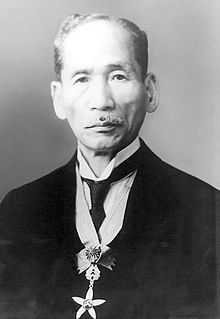Umetaro Suzuki
From Wikipedia, the free encyclopedia

Vitamin research
In 1910, Suzuki succeeded in extracting a water-soluble complex of micronutrients from rice bran and named it aberic acid. He published this discovery in a Japanese scientific journal.[1]
When the article was translated into German, the translation failed to state that it was a newly discovered nutrient, a claim made in the original Japanese article, and hence his discovery failed to gain publicity. Polish biochemist Kazimierz Funk isolated the same complex of micronutrients and proposed the complex be named "Vitamine" (a portmanteau of "vital amine") in 1912.[2]
References
- ↑ Suzuki, U., Shimamura, T. (1911). "Active constituent of rice grits preventing bird polyneuritis". Tokyo Kagaku Kaishi 32: 4–7; 144–146; 335–358.
- ↑ Funk, C. and Dubin, H. E. (1922). The Vitamines. Baltimore: Williams and Wilkins Company.
|
This article is issued from Wikipedia. The text is available under the Creative Commons Attribution/Share Alike; additional terms may apply for the media files.